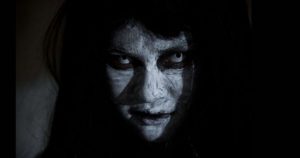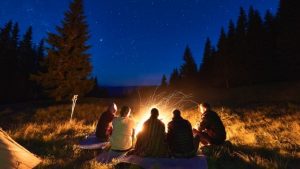[ad_1]
Native peoples who populated the United States long before it was the United States had a deep connection to the land and its creatures. Their stories and rituals were born from that connection, and there are legends from those times that elicit a primal, horrified response from those who hear them today. Here are ten Native American legends that will terrify you.
Related: 10 Legendary Tales About Mythical Creatures
10 Wechuge
Cunning, savage, and patient, the wechuge hunts by drawing its victims into the forest and away from the rest of the tribe. It’s only then that it reveals itself. Massive, monstrous, and made of ice, the wechuge feasts upon lone travelers and incautious members of the Athabaskan tribes in the Canadian Pacific Northwest.
Once men like any other, the wechuge committed any number of social taboos—from allowing their photos to be taken with a flash to playing an instrument made with a stretched string, like a guitar—and thereby invited one of the great animal spirits to overwhelm them with power. If the great spirit was not enticed to leave the man before the transformation was complete, he would eventually eat his own lips and, after that, become a wechuge, cursed to forever hunt and feed upon his own people.[1]
9 Qalupalik
Soaking wet, with slimy green skin and long fingernails, the qalupalik or qallupilluit of Inuit legend resembles nothing more than the reanimated corpse of a drowned woman. In some tellings, their skin is bumpy or scaly, and they always reek of sulfur.
They wear amautiks, the same thing Inuit women wear to carry their children on their backs, but for a very different reason; qalupaliks hunt the ground near thin and broken ice, seeking to snatch up unattended children and carry them back in the amautik to be drowned.
A child wandering too close to the water might hear humming or knocking coming from the ice beneath their feet. Those are sure signs that a qalupalik has sighted them and is trying to lure them closer to the water’s edge. Victims of these creatures are never seen again.[2]
8 Tsul Kalu
Tsul kalu, also known as the Cherokee Devil, is a giant creature, thin and covered in dirty white hair, not unlike a traditional North American bigfoot. His legend originates in what is now North Carolina. To this day, there exist impressions in stones that are said to be from a tsul kalu’s footprints.
As lord of the game (or the hunt) in Cherokee folklore, tsul kalu is said to be able to read minds and hypnotize his victims. His most well-known legend involves taking a Cherokee woman as his bride. The woman’s mother had convinced her that she should take a husband who was a great hunter and could provide for their family. The tsul kalu read those thoughts and appeared to his bride with a deer as an offering.
The Cherokee defended their hunting grounds from the tsul kalu by hanging masks of his face on trees. They believed that there was more than one of the creatures and that if they saw the mask, they would believe they’d wandered into the hunting grounds of a bigger tsul kalu and be frightened away.[3]
7 Skadegamutc

The skadegamutc, or ghost witch, is a monster whose lore originates with the Wabanaki tribes. The legend says that when an evil shaman dies, their desperate need to cling to life can create an unholy creature. The shaman’s body will reanimate at night, and the skadegamutc will roam the forests searching to feast on the blood of hunters and the lost.
The skadegamutc can be fought off, but only with the combined strength of an entire village. Even then, it cannot be killed except by fire. When a ghost witch is encountered by a tribe, they must band together to protect each other at night and spend their days searching for the corpse to burn, lest it claim one of them as a victim after sundown.[4]
6 Ogopogo
Far beneath the surface of Okanagan Lake in British Columbia, there lurks a serpent with the head of a horse and the antlers of a deer. This is no monster, though; it is Ogopogo, the spirit of the lake and protector of the valley.
Both an urban legend reminiscent of the Loch Ness monster that’s been featured on Unsolved Mysteries and a real, sacred belief of the native Okanagan/Syilx indigenous people, Ogopogo represents an intersection of cultures. The dark coloring and horse head are not what you’ll see if you google the creature; instead, you’re more likely to find a cartoon dragon, a mascot that’s been used to sell tourists on visiting the region.
Indigenous people historically made offerings to the spirit of the lake in the form of tobacco, sage, and salmon—and that last one is likely what led to the representation of Ogopogo that one in six adults in British Columbia believe to be real today. When early settlers saw the Syilx people throwing meat into the lake, stories about a great serpent that required meat in order to allow safe passage across the lake spread. Some armed settlers even patrolled the lake’s edge in case the creature attacked.
After years without bloodshed, the monster of Okanagan Lake became toothless folklore and a method of driving tourism.[5]
5 Flathead Lake Monster
Long ago, members of the Kutenai tribe were crossing the frozen Flathead Lake in Montana when two girls came upon a set of antlers jutting through the ice. Believing that an animal must have fallen into the lake, the girls gathered some sharp rocks and set to work breaking apart the ice. It was then that the ice split apart, and the head of a monster appeared. The girls were able to escape its wrath, but it’s said that half the tribe was lost to the frigid waters of the lake that day.
Sightings of the Flathead Lake Monster have persisted for more than a century. There have been more than a hundred reported sightings, beginning with Captain James Kerr and the steamship the U.S. Grant in 1889 and continuing as recently as the fall of 2017. Witnesses describe seeing the water part and a 25-foot (7.6-meter) long, eel-like creature briefly surfacing during encounters.[6]
4 Piasa
Hundreds of years ago, there lived a beast unlike any other. It hunted unseen, the only warning that it was about to snatch up its prey coming as the monster’s great leathery wings blotted out the sun.
The Piasa was a massive avian creature with a tail that wound around its body and through its legs. Shimmering with multicolored scales, the Piasa had a set of antlers rising from the head of a man. It was large enough to carry away an entire deer for a meal, but after one particularly bloody battle between local tribes left many dead near its nest, the Piasa developed a taste for human flesh.
The Illini could not kill the monster despite their best efforts. Desperate for a solution, Chief Ouatoga embarked upon a month-long fast separated from his tribe. On the last night, he was gifted a plan to slay the beast by the Great Spirit; he instructed twenty warriors to hide near the Piasa’s den, and then Ouatoga himself stood defenseless outside to entice the monster. When the great predator emerged, all twenty warriors attacked with a barrage of poisoned arrows and slew it.
The tribe painted the Piasa onto the rocks above the valley as a warning. Those paintings have been lost to time, but in the 1990s, a new painting was commissioned. It now overlooks the Mississippi River near Alton, Illinois.[7]
3 Atahsaia

The demons that stalked the southwestern United States and hunted the Zuni people there knew little fear, but they all feared the great cannibal demon Atahsaia. Twice as large as any man who ever walked the earth, with sharp yellow tusks and a great flint axe, the demon was eternally ravenous—and had a predilection for human meat.
There is a story of a young woman who, desperate to feed her elderly parents, ventured into the forest to hunt. The woman was skilled and caught many rabbits, but as the day turned to night, she was caught in a blizzard and sought refuge in a cave. There, she lit a fire, and her fire drew the attention of Atahsaia.
Too large to enter the cave, Atahsaia stood at its mouth and bellowed at the woman to throw him some meat to curb his appetite. Petrified, she threw each of her rabbits into the monster’s gaping mouth and watched them disappear. Soon, they were gone, and still, Atahsaia hungered. The woman threw her shoes, her clothes, and all of her gear into his mouth. When he’d eaten everything she had to offer, the demon began to hammer at the mouth of the cave with his axe, determined to continue his feast with the huntress.
Hearing the thuds of his axe and at once knowing Atahsaia sought to devour some poor hunter caught in the storm, the war gods Åhayúta and Mátsailéma gathered their weapons and set out to confront the demon. They arrived just as he entered the cave and slew him, then slept at the cave’s mouth to protect the huntress against the night. In the morning, the war gods led her back to her village and gifted her hundreds of rabbits to replace those she’d lost to the demon.[8]
2 Mosquito Man

Long before Edward Cullen or Lestat de Lioncourt, the Mosquito Man haunted the Northwest Coast tribes. The monster looked much like a man, except that instead of a mouth, it had a long proboscis it used to suck the brain out of a person’s head. As clever as any vampire, the Mosquito Man would only appear in groups of people as they celebrated. In that way it was able to avoid detection before it had fed.
In one Haida legend, the Mosquito Man came to a group of brothers who had just returned from a hunt. When the eldest brother’s child began to cry, each man tried in turn to quiet it. When it came time for the Mosquito Man’s turn, the baby quieted, and it was only after he’d passed its body to the next brother that they realized he had feasted on its brain.
The brothers attacked the monster, who became enraged and slew all except the youngest of them. That man he chased all around until, eventually, the brother led the Mosquito Man to the lake. When the creature fell into the water, the Haida tribesman began to sing, and the lake froze, holding the monster with only his head above the ice. The brother then gathered wood and set a fire over the Mosquito Man. The ashes that took flight in the wind afterward became the first mosquitos.[9]
1 The Chindi
When a child is born, a wind enters its body with its first breath; when that same person dies, the chindi is expelled. The Navajo traditionally do their best to ensure that their people die outside so that their chindi can fade away harmlessly; when someone dies inside, the chindi is trapped, and only a ritual cleansing can free that home from the spirit’s wrath.
Chindi are a serious consideration in Navajo culture. Exposure to a chindi can cause ghost sickness, which can lead to sickness and even death. Witches and medicine men with nefarious intentions can use bones or body parts to inflict ghost sickness as well. It was once common for Navajo people to wear jewelry and conduct cleansing rites to protect themselves from death’s reach.[10]
[ad_2]
Source link

Comments are closed.